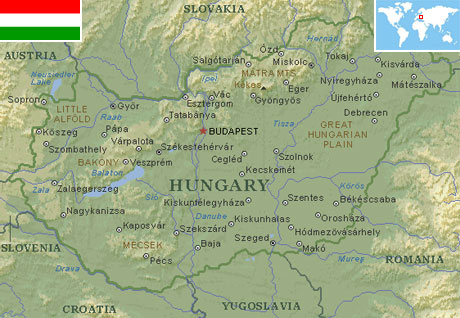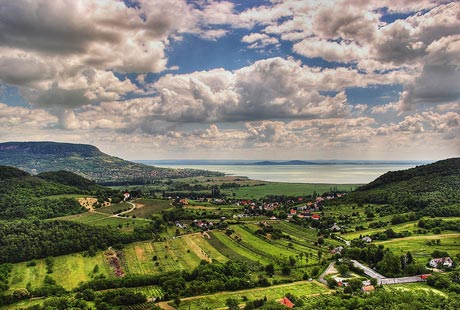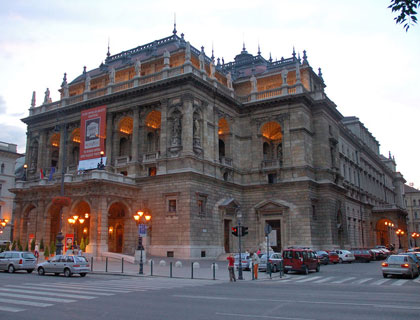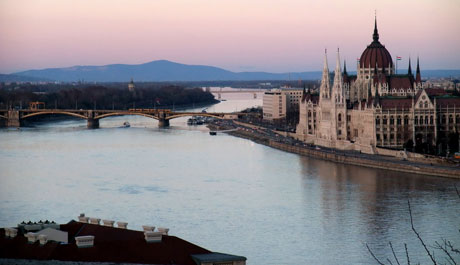Hungary
Country statistics

Land area: 35,653 sq miles (92,341 sq km)
Total area: 35,919 sq miles (93,030 sq km)
Population (2011 est.): 9,958,453 (growth rate: -0.184%); birth rate: 9.49/1000; infant mortality rate: 5.24/1000; life expectancy: 75.02
Capital City: Budapest
Monetary unit: Forint
Languages: Magyar (Hungarian) 94%, other 6%
Ethnicity/race: Hungarian 92.3%, Roma 1.9%, other or unknown 5.8% (2001)
Religions: Roman Catholic 51.9%, Calvinist 15.9%, Lutheran 3%, Greek Catholic 2.6%, other Christian 1%, other 11.1%, unaffiliated 14.5% (2001)
Country introduction

Hungary is a landlocked country in Central Europe. It is situated in the Carpathian Basin and is bordered by Slovakia to the north, Ukraine, and Romania to the east, Serbia, and Croatia to the south, Slovenia to the south-west and Austria to the west. The country's capital, and largest city, is Budapest.
The mountainous and hilly areas in Hungary are to be found in the north of the country as well as hilly areas in Transdanubia which are located in the west of Hungary. Transdanubia is primarily a hilly region with a terrain varied by low mountains. These include the very eastern stretch of the Alps, Alpokalja, in the west of the country, the Transdanubian Mountains, in the central region of Transdanubia, and the Mecsek Mountains and Villány Mountains in the south. The highest point of the area is the Írott-kő in the Alps, at 882 m (2,894 ft).
The River Danube which runs through the country from the north to the south splits the capital of Budapest in two. Other large rivers include the Tisza and Dráva, while Transdanubia contains Lake Balaton, the largest freshwater lake in Central Europe. The second largest thermal lake in the world, Lake Hévíz (Hévíz Spa) is located in Hungary. Lake Tisza, also known as Kisköre Reservoir, is the largest artificial lake in Hungary.
The highest mountains of the country are located in the Carpathians, which lie in the North Hungarian Mountains in a wide band along the Slovakian border. Hungary's highest mountain is the Kékes at 1,014 m (3,327 ft).
A great proportion of the geographical land mass of Hungary consists of flat to rolling plains. The most important plain regions include the Little Hungarian Plain in the west, and the Great Hungarian Plain in the south-east. Hungary has 10 national parks, 145 minor nature reserves and 35 landscape protection areas.
The culture

Hungary was once part of the Austro-Hungarian Empire and due to the historical connection with the Magyars, the tribe which had settled there over a thousand years ago, the country boasts a very diverse and distinct folk tradition which can be seen in the decorated pottery, embroidery and carvings.
Hungary also contains examples from a host of architectural periods, including Roman ruins, medieval castles, Baroque palaces, Art-Nouveau mansions and cutting-edge contemporary buildings. There are remains of ancient castles and centuries-old country houses all over the country.
Hungarians are passionate about folk music and folk culture is an important feature of their national identity. The capital's beautiful State Opera House is world class, and there are several international and cultural music festivals around the country hosting high-quality performances by famous Hungarian and international artists. Contemporary classical music composers recognized globally include Peter Eotvos Gyorgy Ligeti, Zoltan Jeney and Gyorgy Kurtag.
Hungary offers entertainment for those interested in less-mainstream cultural forms, including fashion shows and art-house films. Hungarians have made major contributions to film art and technology. In fact, over 130 people from the country were nominated for Academy Awards in different categories.
Attractions & landmarks

The Balaton region of Hungary features the largest lake in Central Europe and is the place to head to for a truly relaxing and rejuvenating break. Balaton ranks as Hungary's premier resort due to its 170 km (105 miles) of shoreline which provides visitors with picturesque scenery and a host of activities such as fishing, sailing and vast cycling routes. The lake is also popular with bathers and the heady days of summer make for fantastic fun on the water.
Across Hungary there are 135 natural thermal springs and the incredible Lake Hévíz is Europe's largest thermal lake. Despite having an area of 47,500 sq m (155,840 sq ft), the strong flow of water in the lake is thought to completely replenish itself each day and the lake's waters are said to have curative health benefits for bathers.
The Hungarian climate is favourable for producing wine and so the country is home to some 22 wine-making regions with many vineyards offering wine tours and tastings. Hungary's most famous wine region lies in the foothills of the Zemplén Mountains of the far north of the country.
Budapest, split in two by the delightful River Danube, was once known as Buda on the right bank (west) of the river, and Pest on the left (East). Buda and Pest joined as a single city in 1873 and today it is known as one of Europe's finest cities. Landmarks to look out for include the Citadella (Citadel) on Gellért Hill, the riverside Fisherman's Bastion and the Old City Walls, which once completely surrounded the historic city of Pest and were built as a somewhat unsuccessful defensive barrier. Also of interest to many is the Roman theatre of Aquincum, the former name for Budapest, and the simply magnificent Hungarian Parliament Building, which dominates the Pest side of the city.